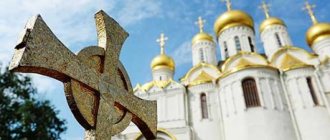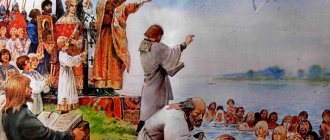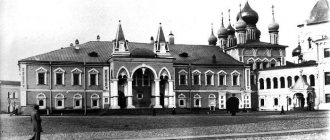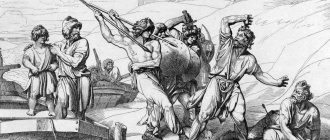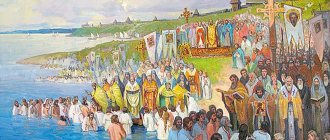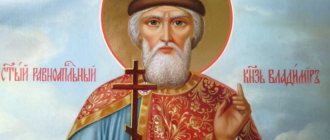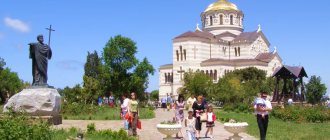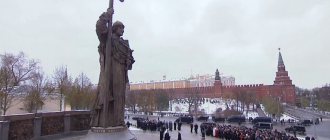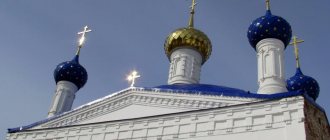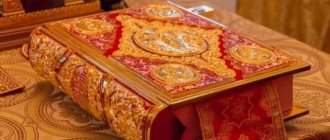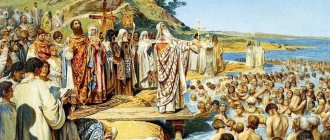Baptism of Rus'
Christianization did not always proceed smoothly. Since the 10th century, there has been plenty of evidence of the forced introduction of a new faith into the masses.
Prince Vladimir instructed his governors to persuade the Slavic tribes to convert to Orthodoxy, among whom the prince’s uncle, Dobrynya, enjoyed special trust. Yes, yes, the same Dobrynya Nikitich, well known to us from epics and legends. “Dobrynya baptized with a sword, and Putyatya with fire” - these words very accurately describe the process of forced Christianization of the population. Exemplary executions of pagans who rejected the new faith gave rise to this saying.
But resistance to baptism has its own background: with the arrival of the Church in the Slavic lands, a new tax was imposed on peasant farmsteads and farms - church tithes. One tenth of the profit received, from the harvest or the offspring of livestock, was to be given to the benefit of the churchmen. Many historians believe that tithing became one of the main “stumbling blocks” in the process of Christianization.
However, the process of introducing Christianity did not meet resistance everywhere. Thanks to the primordial religious tolerance and peacefulness of the Slavs, as well as because of the long neighborhood with Christian preachers, whom Byzantium willingly sent to the Slavic lands, mass baptism took place quite peacefully in many places. Of course, if it were not for the active assistance of the central government, and not for the forceful pressure of Prince Vladimir, then the Christianization of Rus' would probably have lasted for centuries. Since its inception, the Russian Church has always relied on the central government, relying on the power of the state, in return promoting its interests.
Changes in the structure of society
The adoption of Christianity led to the emergence of a completely new class in Rus' - the clergy. Its numbers grew rapidly.
Churches and monasteries are becoming the main spiritual centers in Russia. Until the establishment of the Synod by Peter I (1721), the clergy considered themselves independent of secular power.
Rice. 3. The building of the Senate and Synod in St. Petersburg.
Consequences of the Christianization of Rus'
Many researchers believe that the adoption of Orthodoxy was not only a well-thought-out action on the part of Prince Vladimir, but also a kind of spiritual impulse, a sign of repentance for fratricide and revelry. Be that as it may, it is impossible not to talk about the political and social consequences that the Christianization of Kievan Rus as a state brought.
Thanks to the powerful support of Byzantium, which Rus' received after its baptism, the Slavic state gained considerable weight in the political arena of both Europe and Asia. In addition, the adoption of Christianity made it possible to actively begin to establish relations with those states that professed the same faith. Having received the new status of a “civilized”, rather than pagan, state, the Slavs began to develop trade relations with European countries. Subsequently, these contacts will bring not only economic, but also political benefits, making Kievan Rus a significant player on the world stage.
By starting baptism “from above,” that is, by first baptizing himself, his family and his closest circle, Vladimir created a central vertical of power. The Church became the force that united the scattered Slavic tribes and strengthened the princely power. Existing independently of each other, these two institutions - the church and the state - have always acted together. The church directed its forces to establish the state and support the central government, while the state, in turn, contributed to the prosperity of the church.
It was Christianity that became the central spiritual force that united the people. And even during the period of state fragmentation in the 12th century, the Church remained unchanged, helping the Slavs feel like a single nation.
Another important consequence can be called a general softening of morals. The Church made a lot of efforts to eradicate pagan customs. The cessation of sacrifices and bloody rituals is a direct merit of the new faith. Enlightenment and moral education of the people became the real responsibility of the Christian clergy.
Spiritual and cultural
After the adoption of Christianity, Ancient Rus' received a powerful impetus for the development of literacy and culture, which was taken as a model from Byzantium:
- A new chronology system was established (the new year began on March 1).
- Church holidays came into life.
- Roman counting and the names of the months appeared (Genvar, Fuvroir, and so on).
- The Greek monks Cyril and Methodius brought 2 Slavic alphabet - Cyrillic and Glagolitic, which contributed to the development of Russian writing.
New cultural traditions presupposed the education of a certain segment of the population - priests, craftsmen and politicians. In this regard, literacy schools appeared, from which the first generations of the Russian intelligentsia emerged.
Art (icon painting), architecture, literature and others developed widely. Everything was aimed at the spiritual transformation of man, instilling Christian values. The first books were not of an entertaining nature; they were treated with the utmost seriousness and care.
Kievan Rus sought to form its cultural unity on the basis of spiritual qualities: “mercy” and “conscience” stood higher than “justice” and “law”.
International
In the 9th century, many Western countries (Poland, Denmark, Czech Republic, Hungary and others) adopted Christianity, so the Christianization of Rus' contributed to the expansion of international relations in the West, but at the same time, limiting them with the countries of the East. A single religion helped Ancient Rus' to enter the Christian “family” of European countries and become on the same level with them, absorb their culture and science, and enter a circle of trust. Relations with Byzantium, which at that time was the center of civilization, were significantly strengthened. International trade improved, marriages were concluded with Europeans, which also served to strengthen international ties.
Moral
A radical change in the worldview of Christian Rus' influenced the moral component of its people. So, for a pagan, the main thing is to see off a deceased person with dignity so that he can acquire a better afterlife, but for a Christian: the posthumous fate depends on who the person was all his life. This principle became decisive in people’s actions, which contributed to the formation of the Russian mentality, which persists to this day. The cruel pagan was replaced by a Christian, called to live according to his conscience and the law of God. Polygamy and sacrifices were abolished. The people that were part of Rus' were diverse (Finnish-Ugric, Turkic nomads and others) and had their own traditions. The establishment of a state religion marked the beginning of the unity and formation of the ancient Russian nation, which paganism failed to achieve.
Political
The Church significantly helped in establishing patriarchal statehood: it had a family court in its hands and the government provided material support.
The structure of the state was inherited from Byzantium, where there was a principle: the state is like the human body (body and soul), which means that the state organism requires two branches (secular and spiritual). In this regard, the Russian Orthodox Church became closely connected with politics, and the Metropolitan (then the Patriarch) was the prince's adviser. Thanks to the principle of the divine origin of the head of state, the prince was able to unite the disparate lands of Rus' and strengthen his status.
Economic
After the baptism of Rus', the economy began to develop. Foreign goods from the allied states entered the domestic market, crafts began to develop, and their own coins were minted. The development of trade was facilitated by trust in Russian Christians, while previously they were called “barbarians” and tried not to build economic relations.
Thus, Christian postulates were introduced into all spheres of people’s lives, which determined the further successful development of Rus'.
Attitude and national identity
The paganism of the ancient Slavs was a rather cruel religion. Christianity proclaimed new values:
- virtuous life;
- humility;
- repentance;
- love for one's neighbor.
In the 11th century, the first Russian saints appeared: princes Boris and Gleb, who died as a result of fratricidal civil strife.
Rice. 2. Saints Boris and Gleb. Pskov icon. XIV century.
Briefly about the consequences of the adoption of baptism by Russia is the fact that in the most difficult times the church always made an ardent call for national unification and the fight against foreign invaders. These patriots were:
- Sergius of Radonezh (Tatar-Mongol yoke):
- Patriarch Hermogenes (Time of Troubles);
- Patriarch Sergius (Great Patriotic War).
Even the convinced atheist Stalin during the Great Patriotic War considered it necessary to meet with Russian metropolitans, after which the Russian Orthodox Church was partially legalized.
After the fall of Constantinople in 1453, Russia becomes the largest Orthodox state in the world. As a result, a great power idea emerges - “Moscow is the third Rome.”
The influence of Christianity on the culture of Ancient Rus'
The emergence of Christianity with its rich traditions could not but influence the culture of the Slavs. The new faith required new rituals - and temples and monasteries were actively built throughout the country. Temple architecture, which initially copied the Byzantine style, very quickly came under the influence of the original Slavic traditions. And the monuments of ancient architecture clearly demonstrate this. A good example of such influence is the St. Sophia Cathedral in Novgorod.
Christianization also opened the doors to literary creativity. Thanks to the works of Cyril and Methodius, worship was conducted in a language understandable to everyone, and accordingly, all church literature was also translated into Old Church Slavonic. Very quickly, monasteries and churches acquired their own libraries, and not all of the works in them were translated - Rus' had its own authors of spiritual literature.
With the spread of writing, history also received an impetus for development. Recording current events or chronicling became a voluntary duty of Orthodox monks. That is why written evidence has reached us about the formation of Christianity and the development of Russian statehood from the 10th to 12th centuries.
But Christianity played its main role in the process of unification of Rus'. Orthodoxy became the core around which a single nation began to form from disparate Slavic tribes. The spiritual, cultural, social unity that Christianity provided became a catalyst for the unification of Rus', the creation of a single state with a single people on its territory.
Chapter II . The influence of Orthodoxy on Russian culture.
By the end of the first millennium AD. e. Rus' entered the wide international arena and established the closest relations with the countries of the West and East. Cultural contacts opened the way for religious missionary work among the Slavs. In the period preceding the introduction of Christianity, other faiths competed with Byzantine Christianity, seeking to include Rus' in their sphere of influence. Some sources have preserved traces of the influence of the religious traditions of Bogomilism and Arianism, which were preached in Europe by Irish wandering monks. With the establishment of Orthodoxy, traces of other religious influences were carefully hidden. One might say that the appearance of the original influence and monopoly dominance of the eastern version of Christianity was artificially created.
Close acquaintance with the Eastern Christian empire and the proximity of the Slavs to the Greek colonies in the Black Sea region created favorable opportunities for the spread of the eastern version of Christianity. Ultimately, this predetermined the outcome of the dispute between representatives of religious movements fighting for influence in Rus'. However, the final priority of Byzantium was not established immediately. And the young Slavic-Russian state itself was not a passive recipient. Strong international positions won by force of the sword gave Rus' the right to choose a creed that would not constrain political independence.
The penetration of Christianity among the Slavs began long before it became the state religion. The first Christians were merchants and warriors who lived for a long time in Byzantium. A number of other Byzantine and Arab sources repeatedly speak of Christianity among the Russians.
Thus, the earliest objects of Christian worship that came to Rus' from the countries of the Christian region and were quickly mastered by Russian artisans were encolpions. Already by the 12th century. The production of these cross-vests for storing relics and other shrines became widespread. Items for which the Russian market did not experience a constant need occasionally found their way into the country. Typical, for example, are incense ampoules carried by pilgrims from holy places throughout the Christian world.
The baptism carried out under Vladimir did not become the final stage of the Christianization of the country, but it became an important link in the reconstruction of religious life on new principles. First of all, Christianity was instilled in the social elite of society. In the personal possession of the princes and boyars were expensive liturgical books and literature that set out the main tenets of the new faith. A typical handwritten monument of this kind is the “Svyatoslav Collection” of 1073, decorated with a miniature image of the owner and his family. The collection contains the amount of information necessary for the assimilation of the Christian faith. In addition to purely theological statements, the collection contains a lot of information from the fields of history, geography, astronomy, ancient philosophy, ethics, and grammar.
In ancient Rus', princely power played an important role in establishing the Christian faith. Among the saints canonized by the Russian Church there were many princes. The cult of the first Russian saints Boris and Gleb enjoyed the greatest popularity. The celebration in honor of the saints was introduced in 1072, and by the end of the 11th century. a large number of so-called Borisoglebsk encolpions. They differ from folding doors of a similar type in that instead of plastic images of Christ and the Mother of God, holy princes were placed on the doors. In general, the iconography of Boris and Gleb in ancient Russian art is enormous. We see images of martyred princes on icons, in works of artistic casting, and on enamels. Such a rich variety of incarnations of the image of the first Russian saints is associated with the rapid spread of the cult among the people. The semi-pagan version of this Christian cult has long been noted. The holiday in honor of the saints coincides with the pagan calendar. Early images of saints on enamels reflected precisely the non-Christian side of the cult, for they were framed by green halos and krin sprouts, symbolizing lush vegetation. Contrary to the biography of the princes, the people persistently called them “grain merchants”; obviously, the saints overshadowed some Slavic deities - the patrons of agriculture. The appearance of the saints is somewhat reminiscent of good pagan deities: by performing miracles, the saints act “by their own power” and thereby, as it were, replace divine intervention.
From the 11th to the 13th centuries. The number of items with Christian symbols is gradually increasing. Archaeological finds of a ritual nature objectively reflect the dynamics of the spread of a new faith in society. They also give an idea of the social strata into which Christianity penetrated first. Exquisitely crafted objects made of precious metals clearly indicate the wealth of their owners. Many objects of Christian worship were genuine works of art. They were used by the clergy, both in everyday life and during worship.
As society becomes Christianized, more and more products with Christian symbols appear that are cheap and accessible to the general population. The techniques chosen by ancient Russian masters to embody the image of the cross are difficult to discern. Cast icon pendants and carved slate icons, on which images of popular saints were placed, became widespread.
Crosses in their existence were not always directly related to Christianization. They were often used as simple decorations. Crosses are often found in sets of amulets, where each item had symbolism that was far from Christianity. One can cite various magical actions with a cross that were in no way motivated by the content of Christian teaching. The people firmly held the meaning of the cross as a solar symbol. The cross and cruciformity correlated with the idea of the eternal, immortal, comprehensive, pure, solar divine and masculine life principles.
The dual nature of the cross as the main Christian shrine, on the one hand, and as an ancient pagan symbol, on the other, persisted for a long time. The clergy constantly persecuted all sorts of non-church actions with the cross. Images or sculptures of crosses, which contributed to one degree or another to the preservation of pre-Christian ideas, were ordered to be destroyed.
Under Yaroslav the Wise, Kievan Rus entered a period of its cultural heyday. During this period, the position of the church was strengthened, schools were organized, literacy was spread, and religious and civil construction was carried out on a large scale. Old Russian scribes were recruited to carry out important government tasks.
The development of icon painting and book literature is associated with Christianity in Rus'. The illustrations and screensavers for the books are examples of high craftsmanship. They give an idea of the fine arts and artistic culture of that time. The subjects of the drawings reflect the spiritual atmosphere and aesthetic tastes of the ancient Russians.
The ancestral sign of the Rurik family, to which Vladimir the Baptist belonged, was a trident. At first, after the introduction of Christianity, on silver coins minted under Vladimir, instead of a trident, an image of Christ was placed, and the coin itself turned into a small icon. Then, instead of Christ, they began to mint a trident again, but an additional element was introduced into it - a cross, and a halo began to be placed above the head of the prince sitting on the throne.
Architecture.
If wooden architecture goes back mainly to pagan Rus', then stone architecture is associated with already Christian Russia. Western Europe, which since ancient times built both temples and dwellings of stone, did not know such a transition. Unfortunately, ancient wooden buildings have not survived to this day, but the architectural style of the people has come down to us in later wooden structures, in ancient descriptions and drawings. Russian wooden architecture was characterized by multi-tiered buildings, crowning them with turrets and towers, and the presence of various types of extensions - cages, passages, vestibules. Intricate artistic wood carving was a traditional decoration of Russian wooden buildings. This tradition lives on among the people to this day.
The world of Christianity brought new construction experience and traditions to Rus': Rus' adopted the construction of its churches in the image of the cross-domed temple of the Greeks: a square, dissected by four pillars, forms its basis; rectangular cells adjacent to the dome space form an architectural cross. But the Greek masters who arrived in Rus', starting from the time of Vladimir, as well as the Russian craftsmen working with them, applied this model to the traditions of Russian wooden architecture, familiar to the Russian eye. If the first Russian churches, including the Church of the Tithes, at the end of the 10th century. were built by Greek masters in strict accordance with Byzantine traditions, the St. Sophia Cathedral in Kyiv reflected a combination of Slavic and Byzantine traditions: thirteen cheerful domes of the new temple were placed on the basis of the cross-domed temple. This step pyramid of St. Sophia Cathedral resurrected the style of Russian wooden architecture.
St. Sophia Cathedral, created at the time of the establishment and rise of Rus' under Yaroslav the Wise, showed that construction is also politics. With this temple, Rus' challenged Byzantium, its recognized shrine - Constantine, the Polish St. Sophia Cathedral. In the 11th century St. Sophia Cathedrals grew in other large centers of Rus' - Novgorod, Polotsk, and each of them claimed its own prestige, independent of Kyiv, just like Chernigov, where the monumental Transfiguration Cathedral was built. Monumental multi-domed churches with thick walls and small windows were built throughout Rus', evidence of power and beauty.
Architecture reached great prosperity during the reign of Andrei Bogolyubsky in Vladimir. His name is associated with the construction of the Assumption Cathedral in Vladimir, located on the steep bank of the Klyazma, a white-stone palace in the village of Bogolyubovo, and the “Golden Gate” in Vladimir - a powerful white-stone cube crowned with a golden-domed church. Under him, a miracle of Russian architecture was created - the Church of the Intercession on the Nerl. The prince built this church not far from his chambers after the death of his beloved son Izyaslav. This small single-domed church has become a poem made of stone, which harmoniously combines the modest beauty of nature, quiet sadness, and the enlightened contemplation of architectural lines.
Art.
Old Russian art - painting, carving, music - also experienced tangible changes with the adoption of Christianity. Pagan Rus' knew all these types of art, but in a purely pagan, folk expression. Ancient woodcarvers and stone cutters created wooden and stone sculptures of pagan gods and spirits. Painters painted the walls of pagan temples, made sketches of magic masks, which were then made by artisans; musicians, playing string and woodwind instruments, entertained tribal leaders and entertained the common people.
The Christian Church introduced completely different content into these types of art. Church art is subordinated to a higher goal - to glorify the Christian God, the exploits of the apostles, saints, and church leaders. If in pagan art “flesh” triumphed over the “spirit” and affirmed everything earthly, personifying nature, then church art sang the victory of the “spirit” over the flesh, affirmed the high feats of the human soul for the sake of the moral principles of Christianity. In Byzantine art, considered at that time the most perfect in the world, this was expressed in the fact that there painting, music, and the art of sculpture were created mainly according to church canons, where everything that contradicted the highest Christian principles was cut off. Asceticism and severity in painting (icon painting, mosaic, fresco), sublimity, the “divinity” of Greek church prayers and chants, the temple itself, which became a place of prayerful communication between people - all this was characteristic of Byzantine art. If this or that religious, theological theme was strictly established in Christianity once and for all, then its expression in art, according to the Byzantines, should have expressed this idea only once and for all in an established way; the artist became only an obedient executor of the canons dictated by the church.
And so the art of Byzantium, canonical in content and brilliant in its execution, transferred to Russian soil, collided with the pagan worldview of the Eastern Slavs, with their joyful cult of nature - the sun, spring, light, with their completely earthly ideas about good and evil, sins and virtues. From the very first years, Byzantine church art in Rus' experienced the full power of Russian folk culture and folk aesthetic ideas.
Along with icon painting, fresco and mosaic painting developed. The frescoes of the St. Sophia Cathedral in Kyiv show the writing style of the local Greek and Russian masters, and the commitment to human warmth, integrity and simplicity. On the walls of the cathedral we see images of saints, the family of Yaroslav the Wise, and images of Russian buffoons and animals. Beautiful icon paintings, frescoes, and mosaics filled other churches in Kyiv. Known for their great artistic power are the mosaics of St. Michael's Golden-Domed Monastery with their depiction of the apostles, saints who have lost their Byzantine severity; their faces became softer and rounder.
Later, the Novgorod school of painting took shape. Its characteristic features were clarity of idea, reality of image, and accessibility. From the 12th century Wonderful creations of Novgorod painters have come down to us: the icon “Golden Haired Angel”, where, despite all the Byzantine conventions of the Angel’s appearance, one can feel the tremulous and beautiful human soul. Or the icon “Savior Not Made by Hands” (also 12th century), in which Christ, with his expressive arched eyebrows, appears as a formidable, all-understanding judge of the human race. In the icon of the Dormition of the Virgin Mary, the faces of the apostles depict all the sorrow of loss. And the Novgorod land produced many such masterpieces.
The wide distribution of icon painting and fresco painting was also characteristic of Chernigov, Rostov, Suzdal, and later Vladimir-on-Klyazma, where wonderful frescoes depicting the “Last Judgment” decorated St. Demetrius Cathedral.
Gradually, spiritual music was formed, written specifically to accompany religious cult rituals, which evoked a whole range of experiences and moods among believers.
Applied, decorative art and religious objects, used during worship or constantly present in the interiors of churches, sometimes acquired a non-ecclesiastical sound. Altars, candlesticks, crosses, cassocks, cassocks, miters, all the attire of the priests were not so much works of worship as of applied art.
Literature and chronicles.
In Ancient Rus' they wrote on parchment (a specially prepared calf or lamb skin). The books were bound in leather and richly decorated with gold and precious stones.
In connection with the spread of Christianity in Rus' (mainly in monasteries), schools for “book learning” began to be created. Literacy spread quite widely, as evidenced, first of all, by birch bark letters discovered in Novgorod dating back to the 11th-12th centuries. Among them are private correspondence, business documents, even student records.
In Kyiv, an extensive library was created at the St. Sophia Cathedral. Similar collections of books existed in other rich churches and large monasteries.
Greek liturgical books, works of the church fathers, lives of saints, historical chronicles, and stories were translated into Russian.
Already in the 11th century. The formation of ancient Russian literature proper begins. The leading place among literary works belonged to chronicles. The largest chronicle of Kievan Rus - “The Tale of Bygone Years” (PVL) - arose at the beginning of the 12th century. The PVL has reached us in two editions, which were formed in the 14th-15th centuries. PVL became the basis of Russian chronicles. It was included in almost all local chronicles. The most important themes of the PVL were the defense of the Christian faith and native land. The author of the PVL is usually called the monk of the Kiev-Pechersk Monastery Nestor. However, in essence this is a collective work, in the compilation and revision of which several chroniclers took part. The chronicler did not observe events dispassionately. The chronicle was a political document and therefore was often revised in connection with the coming to power of a new prince.
The chronicles often included journalistic and literary works. “The Sermon on Law and Grace” by Metropolitan Hilarion (the first metropolitan of Russian origin), written in the second third of the 11th century, was dedicated to the glorification of Christianity and the justification of the independence of Rus' in relation to Byzantium. In the “Instructions” of Vladimir Monomakh, the image of an ideal prince was created, courageous in battle, caring towards his subjects, caring for the unity and well-being of Rus'.
An important type of reading for medieval Russians was the lives of saints. Rus' began to create its own hagiographic literature. Among them are “The Tale of Boris and Gleb”, “The Lives” of Princess Olga, Abbot of the Kiev-Pechersk Monastery Theodosius, etc.
In the Middle Ages, people rarely left their native lands. The greater the interest in distant countries. That is why the genre of “walkings” and travel stories is so characteristic of medieval literature. This direction of ancient Russian literature includes the “Walking” of Abbot Daniel, who made a pilgrimage to Palestine.
An integral part of the art of Rus' was the art of music and singing. In “The Tale of Igor’s Campaign,” the legendary storyteller-singer Boyan is mentioned, who “let” his fingers onto the living strings and they “themselves rumbled glory to the princes.” On the frescoes of the St. Sophia Cathedral we see images of musicians playing woodwind and string instruments - lute and harp. The talented singer Mitus in Galich is known from chronicle reports. Some church writings directed against Slavic pagan art mention street buffoons, singers, and dancers; There was also a folk puppet theater. It is known that at the court of Prince Vladimir, at the courts of other prominent Russian rulers, during feasts those present were entertained by singers, storytellers, and performers on stringed instruments.
And, of course, an important element of the entire ancient Russian culture was folklore - songs, tales, epics, proverbs, sayings, aphorisms. Wedding, drinking, and funeral songs reflected many features of the life of people of that time. So, in ancient wedding songs they spoke about the time when brides were kidnapped, in later ones - when they were ransomed, and in songs from Christian times they talked about the consent of both the bride and parents to marriage.
The whole world of Russian life is revealed in epics. Their main character is a hero, a defender of the people. The heroes had enormous physical strength. So, about the beloved Russian hero Ilya Muromets it was said: “Wherever you turn, there are streets, wherever you turn there are alleys.” At the same time, he was a very peace-loving hero who took up arms only when absolutely necessary. As a rule, the bearer of such irrepressible power is a native of the people, a peasant son. The people's heroes also possessed enormous magical power, wisdom, and cunning. So, the hero Volkhv Vseslavich could turn into a gray falcon, a gray wolf, and could become Tur-Golden Horns. People's memory has preserved the image of heroes who came not only from the peasant environment - the boyar's son Dobrynya Nikitich, the cunning and resourceful representative of the clergy Alyosha Popovich. Each of them had its own character, its own characteristics, but all of them were, as it were, exponents of people's aspirations, thoughts, and hopes. And the main one was protection from fierce enemies.
Everyday life.
The culture of a people is inextricably linked with its way of life, everyday life, just as the life of the people, determined by the level of development of the country’s economy, is closely connected with cultural processes. The people of Ancient Rus' lived both in large cities for their time, numbering tens of thousands of people, and in villages in several dozen households and villages, especially in the northeast of the country, in which two or three households were grouped.
All contemporary evidence suggests that Kyiv was a large and rich city. In terms of its scale, many stone temple buildings, palaces, it competed with other European capitals of that time. It is not for nothing that the daughter of Yaroslav the Wise, Anna Yaroslavna, who came to Paris in the 11th century, was surprised by the provinciality of the French capital in comparison with Kiev, which was shining on the way “from the Varangians to the Greeks.” Here the golden-domed temples shone with their domes, the palaces of Vladimir, Yaroslav the Wise, Vsevolod Yaroslavich amazed with their grace, the St. Sophia Cathedral and the Golden Gate, a symbol of the victories of Russian weapons, surprised with their monumentality and wonderful frescoes. And not far from the princely palace stood bronze horses taken by Vladimir from Chersonesus; in the old city there were palaces of prominent boyars, and here on the mountain there were also houses of rich merchants, other prominent citizens, and the clergy. Houses were decorated with carpets and expensive Greek fabrics. From the fortress walls of the city one could see the white stone churches of Pechersky, Vydubitsky and other Kyiv monasteries.
In the palaces and rich boyar mansions there was a life of its own - warriors and servants were located here. From here the administration of principalities, cities, and villages took place; judgments were made here; tributes and taxes were brought here. Feasts were often held in the vestibule, in the spacious grits, where overseas wine and their native “honey” flowed like a river, and servants served huge dishes of meat and game. Women sat at the table on equal terms with men. Women generally took an active part in management, housekeeping, and other matters. There are many known women who are figures of this kind: Princess Olga, Monomakh’s sister Yanka, mother of Daniil Galitsky, wife of Andrei Bogolyubsky, etc. Guslyars delighted the ears of eminent guests, sang “glory” to them, large bowls, horns of wine went around in a circle. At the same time, food and small money were distributed to the poor on behalf of the owner. Such feasts and such distributions were famous throughout Rus' during the time of Vladimir I.
The favorite pastimes of rich people were falconry, hawk hunting, and hound hunting. Races, tournaments, and various games were organized for the common people. An integral part of ancient Russian life, especially in the North, however, as in later times, was the bathhouse.
In the princely-boyar environment, at the age of three, a boy was put on a horse, then given to the care and training of a pestun (from “to nurture” - to educate). At the age of 12, young princes, together with prominent boyar advisers, were sent to manage volosts and cities.
On the banks of the Dnieper, a cheerful Kiev trade was noisy, where, it seems, products and products were sold not only from all over Rus', but also from all over the world of that time, including India and Baghdad.
His life, full of work and anxiety, flowed in modest Russian villages and hamlets, in log huts, in semi-dugouts with stoves in the corner. There people stubbornly fought for existence, plowed up new lands, raised livestock, beekeepers, hunted, defended themselves from “dashing” people, and in the south - from nomads, and again and again rebuilt the dwellings burned by their enemies. Moreover, often plowmen went out into the field armed with spears, clubs, bows and arrows to fight off the Polovtsian patrol. On long winter evenings, women spun by the light of splinters. The men drank intoxicating drinks and honey, recalled days gone by, composed and sang songs, and listened to epic storytellers.
Religion embraced the entire consciousness of man, and the development of culture was also inseparable from religion. Therefore, it is natural that monasteries became the center of concentration of culture.
Monasticism is often accused of stifling culture; it should be argued that it was the monks in the early Middle Ages who carried and preserved cultural norms. The path of the ascetic presupposed his inclusion in culture, otherwise, on the path of improvement, he would inevitably depart from the path of spiritual improvement. The monasteries that emerged subsequently were by no means “breeding grounds for hopeless asceticism.” Monasteries became centers of book learning, where hardworking monks copied chronicles and ancient manuscripts. The monasteries were also distinguished by a high aesthetic level of religious activity: church singing, liturgical speech. It was in the monasteries that painting, especially icon painting, and architectural creativity flourished.
In the images of church architecture, not only art and religion, but also almost all types of other arts were fused into an organic unity: painting, music, poetry, sculpture, applied and decorative arts, design (especially during services in the temple).
It was during the Middle Ages in Rus' that significant successes were achieved in the development of scientific, engineering and technical thought, especially related to architecture and the art of construction. High examples of medieval art constituted an era in the development of world culture, unique, gifted to all subsequent generations. The source of inspiration of the great masters of the Middle Ages and the only language accessible to a wide range of consumers of the culture of this time was faith in Christ.
